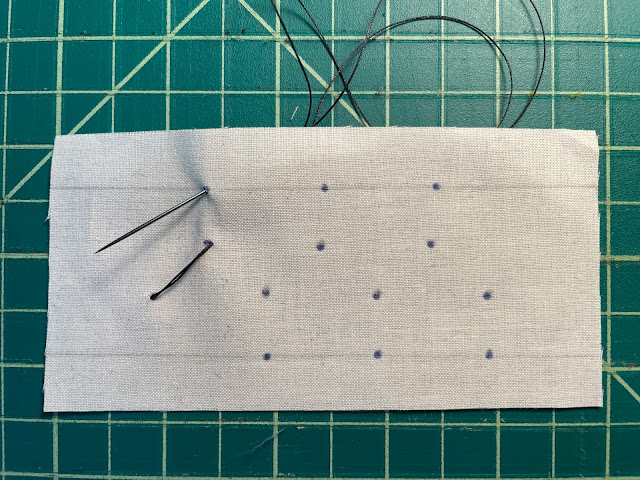After finding one book in the library by Natalie Chanin and making my quilt, "Keystones," my tendency for obsession (call it research) kept me browsing the Alabama Chanin website and ultimately buying the digital pattern for the "corset" as well as The Geometry of Hand-Sewing, the book of stitching patterns, which comes with plastic pre-punched cards to practice stitching or use as a template.
The corset, like all of her patterns, is meant to be hand sewn, the pieces held together with running/straight stitches that are then folded over and stitched down (felled). For the binding, a decorative and stretchy stitch is suggested: the Cretan Stitch. I have a little trouble following hand-drawn diagrams, so I had to study it a while.
I was able to understand the stitch, get the pattern like a dance step, and work on getting the stitches even (not quite there yet), and finish the garment. Good enough for a first try, is my thought. (The Little House pins are small and very sharp, both they and the pin cushion ring are from Kimonomomo).
It also occurred to me that it would be a nice decorative stitch for a side or stab binding of a book. For the garment, the bottom stitch (in my case) wrapped around the raw edge of the neck and arm edgings and just pierced at the fold. For a book, in place of the top set of holes, the thread could wrap around the spine. The example has exaggerated holes for clarity. It would work and look better with a smaller needle and soft covers.
Here's the actual pattern. There are four rows of holes. One row instead of holes could be around the edge of the book (as shown above) or the raw edge of cloth (as shown with the corset).
Natalie Chanin recommends Button Craft Thread; it is heavy duty, keeps the garment together when washed, and shows up well. It would be great for bookbinding as well since it does not break or stretch. I found it at JoAnn's as "Button & Craft" thread. Sewing the corset together plus the edgings took one full spool of 50 yards.
I'm going to name these holes, starting with lower left:
- lower (or lower middle zig-zag)
- upper (or upper middle zig-zag)
- top
- and bottom
Think about the direction you are sewing as you stitch. When you sew towards the top you will stitch into the upper middle, when you sew towards the bottom, stitch into the lower middle.
1. Knot the thread and come up at lower middle. You are heading toward the top now.
2. Sew into upper middle hole to make a diagonal stitch.
3. Come up through the top. (This hole is straight up from your last hole.)
4. Now you are heading back down. Take your needle under the stitch you just made with the two middles. Sometimes I will say loop it under, sometimes I might say catch the stitch.
5. Sew down into the next lower middle.
6. Sew up from the bottom. (This hole is directly straight down.)
7. Coming up again. Loop under the stitch.
8. Sew into upper middle (this makes a diagonal stitch again).
9. Sew up through the top. (Straight up).
10. Coming down again. Loop under the diagonal stitch.
11. Sew down into lower middle (you're going diagonally).
12. Sew up through the bottom (this is straight up).
13. Loop under the diagonal stitch.
14. Coming up again. Sew into the upper middle.
You can see the pentagon/house shape emerging, both right-side up and upside down.
15. Sew up at the top.
16. Coming down again. Go/loop under the diagonal stitch in the direction you are sewing (in this case, as always per these instructions, to the right).
17. Sew down into the lower middle hole.
Then continue the pattern: up from the bottom, catch and under, down into the upper, up from the top, catch and under, down into the lower. And so on. Repeat until you've completed the project.
I found that seeing the back helped. You can see how the stitches can either anchor the spine of a book or the raw edge of a cloth edge binding.
It takes some time to get into the rhythm and get the spacing straight if you haven't marked it.
The Alabama Chanin brand uses organic cotton knit or vintage t-shirts for all their clothes. Spoonflower has organic cotton knit that can be ordered with any decorative pattern printed on it (including mine, shown here). I cut this corset from stretch velvet. And I just ordered the "Factory Dress" pattern. I'm going to hand dye some
cotton jersey from Dharma for the dress. Making a garment is satisfying.
Corset front
Corset back




























Comments